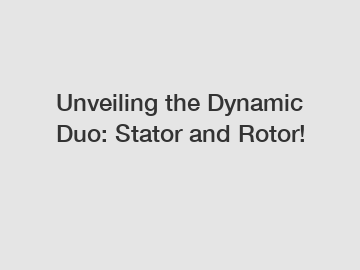Unveiling the Dynamic Duo: Stator and Rotor!
Unveiling the Dynamic Duo: Stator and Rotor!
When it comes to understanding the mechanism behind electric motors, one simply cannot overlook the importance of the dynamic duo: the stator and the rotor. These two components are crucial for the functioning of electric motors, and their harmonious collaboration enables the conversion of electrical energy into mechanical energy. In this article, we will delve into the intricate relationship between the stator and rotor, exploring their origins, the process of their synergistic operation, and the profound significance and impact they have in various industries.
The origins of the stator and rotor can be traced back to the early years of electric motor development. In the 19th century, renowned inventors such as Michael Faraday and Nikola Tesla laid the foundation for the modern electric motor by discovering the principles of electromagnetic induction. Faraday's experiments with electromagnetic fields and Tesla's application of alternating current principles paved the way for the development of the stator and rotor.

At its core, the stator is a stationary component of an electric motor, typically consisting of a series of coils wound around a magnetic core. These coils create a magnetic field when an electrical current is passed through them. On the other hand, the rotor is the rotating part of the motor, usually made up of a set of conductive bars or coils that are connected to a shaft. The rotor is positioned within the stator and forms a complementary magnetic field.
The key to the operation of an electric motor lies in the interaction between the stator's magnetic field and the rotor's magnetic field. When an electric current is supplied to the stator, it creates a magnetic field that acts upon the rotor. Due to this interaction, the rotor experiences a force that causes it to rotate. The rotation of the rotor, in turn, creates mechanical energy that can be utilized for various applications.
The significance of the stator and rotor in electric motors cannot be overstated. These components form the basis of numerous industrial applications, ranging from electric vehicles and household appliances to industrial machinery and power generation. The efficiency and performance of an electric motor heavily rely on the design and optimization of the stator and rotor. By improving the magnetic properties, reducing losses, and enhancing the mechanical integrity of these components, engineers and researchers strive to boost the overall efficiency and reliability of electric motors.
Furthermore, the development of advanced stator and rotor designs has led to significant environmental advantages. Electric motors, powered by renewable energy sources, have emerged as a key player in the global transition towards sustainable energy systems. The continuous refinement of stator and rotor technologies plays a crucial role in promoting energy efficiency, reducing carbon emissions, and creating a greener future.
In conclusion, the stator and rotor form an inseparable duo in the realm of electric motors. Their concerted effort enables the conversion of electrical energy into mechanical energy, powering a vast array of industrial applications. With their origins rooted in the groundbreaking discoveries of electromagnetic principles, the stator and rotor continue to evolve and contribute to advancements in efficiency, reliability, and environmental sustainability. As we forge ahead into the era of clean energy, the dynamic duo will undoubtedly remain at the forefront of technological progress.
If you want to learn more, please visit our website dc motor stator and rotors, lamination welding, custom electric motor stator and rotor cores.
129
0
0


Comments
All Comments (0)